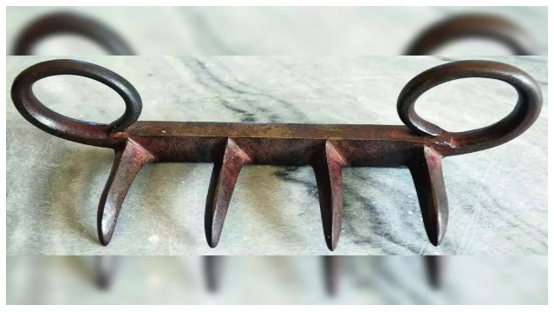- Courses
- GS Full Course 1 Year
- GS Full Course 2 Year
- GS Full Course 3 Year
- GS Full Course Till Selection
- CSAT
- 5 LAYERED ARJUNA Mentorship
- Public Administration Optional
- Online Program
- GS Recorded Course
- NCERT Batch
- Polity Module Course
- Geography Module Course
- Economy Module Course
- AMAC Module Course
- Modern India, Post Independence & World History Module Course
- Environment Module Course
- Governance Module Course
- Science & Tech. Module Course
- International Relations and Internal Security Module Course
- Disaster Management Module Course
- Ethics Module Course
- Essay Module Course
- Current Affairs Module Course
- ABOUT US
- OUR TOPPERS
- TEST SERIES
- FREE STUDY MATERIAL
- VIDEOS
- CONTACT US
Wagh Nakh
Wagh Nakh
10-10-2023

Latest Context
On 3 October, 2023 Maharashtra’s Cultural Affairs Ministry has signed a Memorandum of Understanding (MoU) with the Victoria and Albert Museum in London to bring back Chhatrapati Shivaji Maharaj’s legendary “Wagh Nakh” a formidable medieval weapon to the state.
- The MoU states that the antique weapon will be handed over to the Government of Maharashtra on a loan basis for a period of three years, during which it will be displayed in museums across the state.
Wagh Nakh
- It is literally translating to 'tiger claws,' is a unique medieval dagger used across the Indian subcontinent.
- This fearsome weapon featured four or five curved blades affixed to a glove or a bar, designed for personal defence or stealth attacks.
- Its sharp blades were capable of slicing through skin and flesh with ease.
2. Chhatrapati Shivaji's Defense with the 'Wagh Nakh':
- Chhatrapati Shivaji faced Afzal Khan, a Bijapur general assigned to stop Shivaji's strong campaigns in the Konkan. Khan suggested a peaceful meeting, but Shivaji, anticipating danger, came prepared.
- He concealed a 'Wagh Nakh' and wore chainmail (armour made from small metal rings) under his attire.
- When Khan attacked, Shivaji's 'Wagh Nakh' struck, resulting in Khan's death, ultimately securing Shivaji's victory.
Chhatrapati Shivaji Maharaj
-
Birth
- Born on 19th February 1630, at Shivneri Fort in Pune District, Maharashtra.
- He was the son of Shahaji Bhonsle, a Maratha general with jagirs in Pune and Supe under the Bijapur Sultanate, and Jijabai, a deeply religious woman who greatly influenced him.
-
Important Battles

-
Titles
- He took on the titles of Chhatrapati, Shakakarta, Kshatriya Kulavantas and Haindava Dharmodhhaarak.
-
Administration under Shivaji

-
Central Administration:
- He established a centralised administration with a council of eight ministers (Ashtapradhan) who were directly responsible to him and advised him on various matters of the state.
- The Peshwa, also known as the Mukhya Pradhan, originally headed the advisory council of Raja Shivaji.
-
Provincial administration:
- Shivaji divided his kingdom into four provinces.
- Each province was further divided into districts and villages.
- The village was the basic unit of administration and was governed by a Deshpande or Patel with the help of a village panchayat.
- Like the centre, there was a committee or council of eight ministers with Sar-i- ‘Karkun’ or the ‘prantpati’ (Head of the province).
-
Revenue Administration:
- Shivaji abolished the Jagirdari System and replaced it with the Ryotwari System, and made changes in the position of hereditary revenue officials which were popularly known as Deshmukhs, Deshpande, Patils , and Kulkarnis.
- Shivaji strictly supervised the Mirasdars who had hereditary rights in land.
- The revenue system was patterned on the Kathi system of Malik Amber in which every piece of land was measured by Rod or Kathi.
- Chauth and Sardeshmukhi were other sources of income.
- Chauth amounted to 1/4th of the standard that was paid to Marathas as a safeguard against Shivaji’s forces raiding non-Maratha territories.
- Sardeshmukhi was an additional levy of 10% demanded from areas outside of the kingdom.
-
Military Administration:
- Shivaji established an efficient army, paying ordinary soldiers in cash and high-ranking officials through jagir grants (Saranjam).
- His military included infantry (Mavali foot soldiers), cavalry (horse riders and equipment handlers), and a navy.
- Key roles included the Sar-i-Naubat (Senapati) in charge of the army, Qiladars overseeing forts, Nayaks leading infantry units, Havaldars heading groups of five Nayaks, and Jumladars overseeing five Nayaks.
Death:
- Shivaji passed away in Raigad in 1680 and was cremated at the Raigad Fort.
- Shivaji Maharaj Jayanti is celebrated each year on 19th February



